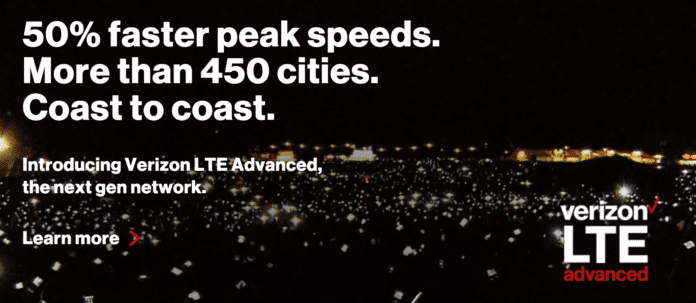Carrier aggregation will add capacity for Verizon subs with compatible devices
The Verizon Wireless homepage on Monday was dedicated to a countdown timer, which, at 10:30 a.m. Central Standard Time, gave way to the headline: “50% faster peak speeds. More than 450 cities. Coast to coast. Introducing Verizon LTE Advanced, the next-gen network.”
According to the carrier, LTE-Advanced deployments will improve peak data speeds by 50% in 461 markets across the country.
Here’s a list of 39 LTE Advanced-capable phones and tablets.
“Our customers just received a major network enhancement for no additional cost,” said Tami Erwin, head of operations for Verizon’s wireless unit. “Verizon LTE Advanced works like a turbocharger on an engine. Speed boosts kick in when you need it most, with big data use. That’s when you get the big peak boost of Verizon LTE Advanced.”
Verizon said it’s using carrier aggregation, both two-channel and three-channel, that combines holdings in the 700 MHz, 1.7/2.1 GHz and 1.9 GHz spectrum bands to power the offering. According to Verizon, two-channel carrier aggregation can boost peak download speeds to 225 Mbps, and three-channel carrier aggregation can boost speeds to around 300 Mbps.
“Verizon LTE Advanced means your data session moves more quickly over the best network,” said Nicki Palmer, Verizon’s chief wireless network engineer. “Imagine a road with multiple lanes in which, once you pick a lane, that’s the lane you drive in. That describes our award-winning 4G LTE network. Continuing the metaphor, Verizon LTE Advanced allows cars to change lanes efficiently and flawlessly, balancing the flow of traffic and getting drivers to their destinations more efficiently. That means blindingly fast data transmissions when you need it most.”
Verizon Wireless’ initial LTE deployment relied on 20-megahertz of nationwide 700 MHz spectrum the carrier acquired as part of the Federal Communications Commission’s Auction 73 process in 2008, as well as separate deals that helped fill in coverage gaps. In 2014, the carrier rolled out its XLTE program, which included the addition of up to 20-megahertz of additional spectrum in the 1.7/2.1 GHz bands acquired in spectrum auctions and additional deals.
The XLTE move did not involve carrier aggregation, and instead only provided for cleaner spectrum assets in order to better serve more congested markets. This was highlighted by the carrier sticking with its advertised download speeds of between 5 Mbps and 12 Mbps.
More recent, Verizon Wireless has looked to tap its 1.9 GHz spectrum holdings that had been serving as the base layer of coverage for its data-focused CDMA2000 1x EV-DO Revision A 3G service. However, with a majority of its data traffic now traveling over its LTE network, the carrier is looking to reduce spectrum support for its legacy CDMA network. This includes its recent launch of voice-over-LTE services, which will eventually allow the carrier to migrate voice traffic from is CDMA-based 2G network and begin to refarm the 850 MHz spectrum currently supporting that network.

